Balloon Boy Helium Physics – How Much Helium Would It Take to Lift Falcon?
Since the location of the Balloon Boy saga is about 60 miles north of our offices in Englewood, Colorado, we’ve received a number of phone calls and e-mails about the science of helium… specifically the lifting power of this inert gas. We decided to show our partners at KUSA and 9News.com what it would take to lift a 10 pound sack of potatoes.
[youtube width=”560″ height=”344″]http://www.youtube.com/watch?v=AE65US7SwCM[/youtube]
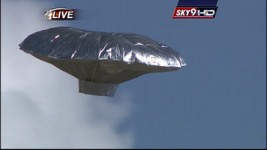 According to news reports, the Jiffy-Pop-shaped balloon that captivated the world on Thursday as it floated across the state measured about 20 feet across and 6 feet tall, but it was easy to see that the balloon wasn’t fully inflated even at the time of lift off.
According to news reports, the Jiffy-Pop-shaped balloon that captivated the world on Thursday as it floated across the state measured about 20 feet across and 6 feet tall, but it was easy to see that the balloon wasn’t fully inflated even at the time of lift off.
What is the lifting power of helium? For the sake of time and a more detailed explanation, here’s a simple data table that will give you an idea of what it would take to lift a person using a helium balloon. We’re assuming standard temperatures and pressures and no significant overpressure. Please note that we’re using “cubic feet” and “pounds” to match the English units that everyone is using in the news.
For reference purposes, you should know that a large tank of helium – the kind you find at a grocery store or party shop, holds approximately 250 cubic feet of helium. Based on the calculations below, you can see that 250 cubic feet will lift roughly 17 pounds. In our video test for KUSA 9News, we found that 250 cubic feet lifted about 8 pounds of potatoes, plus the string and the weight of the 45 large balloons (2.3 pounds). All in total, we lifted just over 10 pounds.
 Balloon Volume Lifting Power
Balloon Volume Lifting Power
Diameter (ft) Cubic Ft Pounds
1 0.52 0.03
2 4.19 0.27
3 14.13 0.91
4 33.51 2.15
5 65.45 4.19
6 113.10 7.25
7 179.61 11.51
8 268.10 17.18
9 381.73 24.46
10 523.63 33.55
11 696.95 44.65
12 904.83 57.97
13 1150.42 73.71
14 1436.84 92.06
15 1767.25 113.23
16 2144.79 137.42
17 2572.60 164.83
18 3053.82 195.66
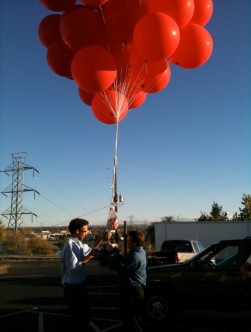 Why didn’t we lift the calculated weight of 17 pounds? As you can imagine, we’re working with lots of assumptions. The company supplying the helium told us that the larger cylinder holds about 250 cubic feet. Each red balloon held approximately 5 cubic feet of helium, and we were able to inflate just 45 balloons (that’s 225 cubic feet of gas). To top everything off, we lost 5 of our balloons during the test (a few pops and 3 into the sky). These are the results based on an impromptu science experiment with a single tank of helium.
Why didn’t we lift the calculated weight of 17 pounds? As you can imagine, we’re working with lots of assumptions. The company supplying the helium told us that the larger cylinder holds about 250 cubic feet. Each red balloon held approximately 5 cubic feet of helium, and we were able to inflate just 45 balloons (that’s 225 cubic feet of gas). To top everything off, we lost 5 of our balloons during the test (a few pops and 3 into the sky). These are the results based on an impromptu science experiment with a single tank of helium.
Since most of use don’t have a giant, Mylar, flying muffin balloon the likes of the Heene family, we wanted to use something a little more common (big red balloons) to get an idea of the science behind the lifting power of helium.
For additional information about the lifting power of common gases, visit the University of Hawaii’s website. If you’re wondering more about the science of helium, the chemistry department provided this information…
Helium is mined, or more exactly drilled for. In the Oklahoma and Texas panhandles are natural gas wells that contain up to 4% or more Helium. This natural resource is very rare. The gas field must be encased in radioactive rock or no helium is produced. The alpha particle decay in the surrounding radioactive rock over millions and millions of years creates the helium. An alpha particle is just a helium nucleus. When it slows down and regains its two electrons, it becomes a helium molecule. Thus the radioactive rock makes helium, one molecule at a time, to accumulate in the same pocket as the natural gas.
In the 1930’s Germany asked the USA many times for helium for its Zepplins. The US was concerned that helium had other military uses and horded it as a strategic material. For this reason, the Hindenburg was still lofted with hydrogen on its last disastrous flight, instead of being converted to helium as Germany had been trying to do for years.
Helium is a natural byproduct of the liquefaction of the natural gas for pipeline shipment from these special gas fields. Helium liquefies at a much lower temperature than natural gas, close to absolute zero (4 degrees Kelvin). The volume left over after liquefaction is mostly helium ready to be stripped off and sold to the US Government Bureau of Mines. Few people seem concerned that this is a non-renewable and expendable natural resource, tied to very few gas wells in the world.
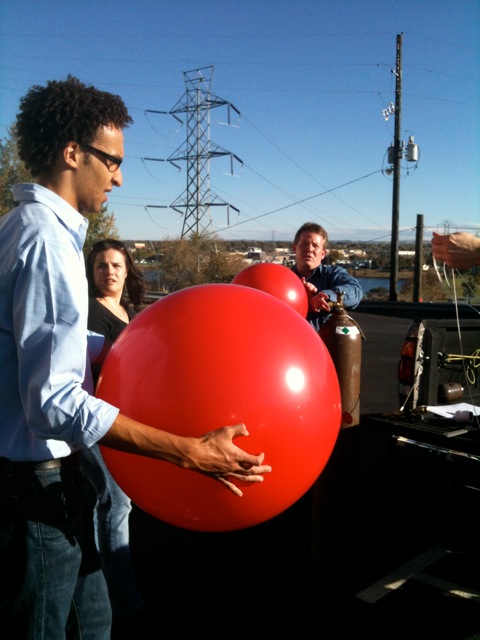
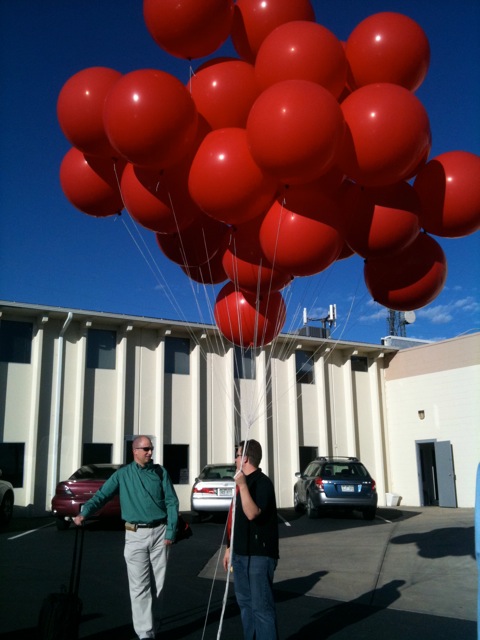
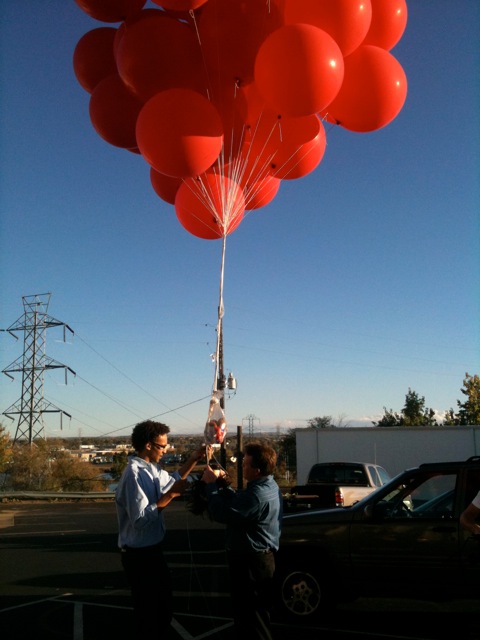
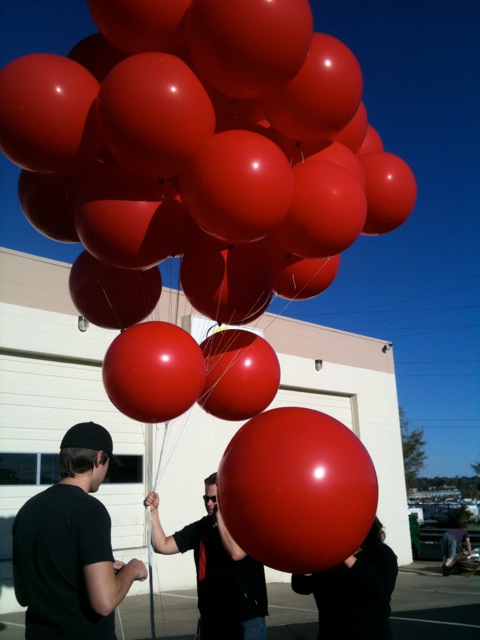
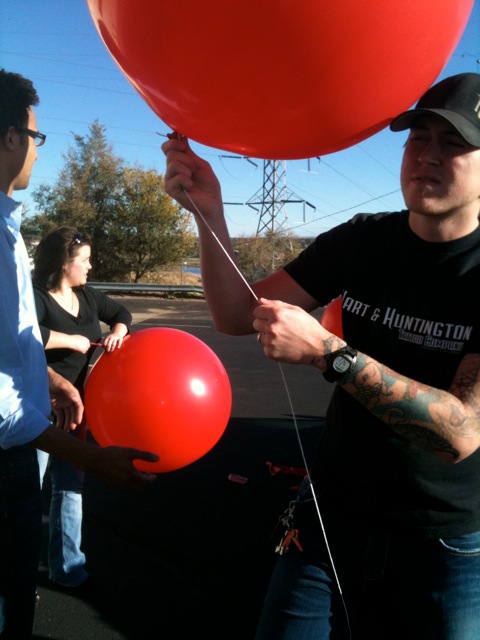
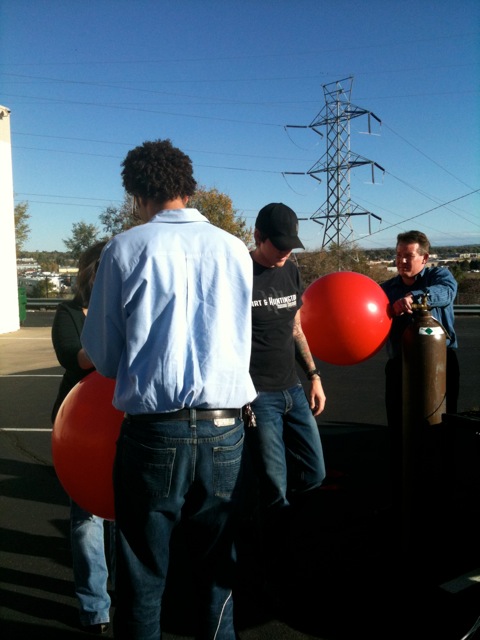
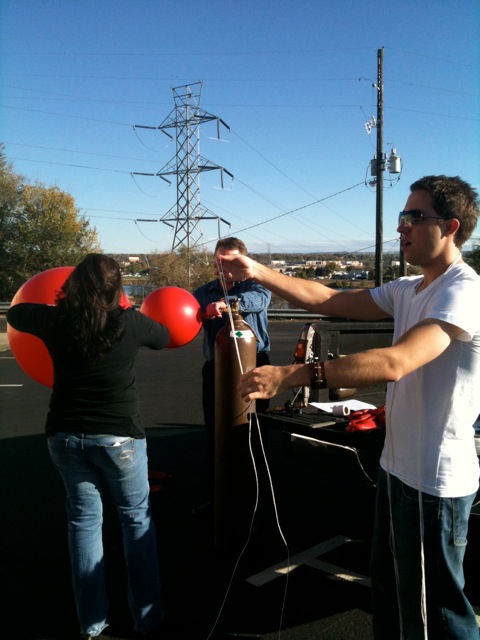

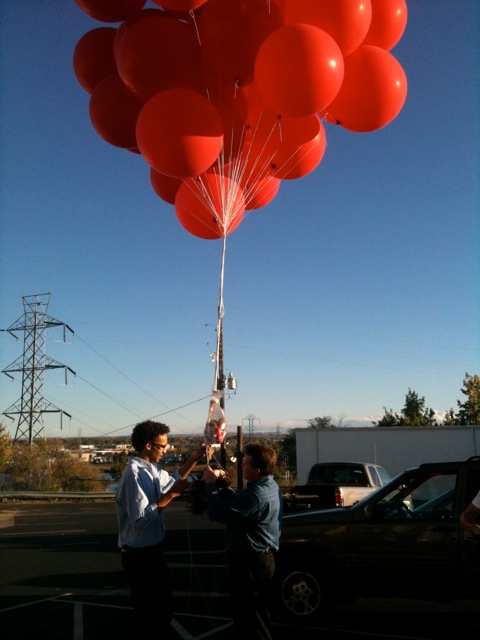




Based on this data, the Heene balloon would have been near 600 cu ft on the best assumption. (20’x6′ cylinder) So with the chart above would give it about 38lb of total lift capacity. I don’t know what a 6 yr old weighs, but I imagine it is more than that, especially when the weight of the balloon is taken into account.
Also when I first saw the video, it did not appear to fly as if it had a reasonable ballast, as one might expect from a balloon that is near its weight carrying capacity, so from that aspect I was doubtful that it carried any significant weight.
Heene as a self proclaimed “scientist” showed little logical thinking in assuming the balloon was carrying his child. With simple math and a web search, he could have easily determined the max weight expectations.
The point of our simple experiment was to show the lifting power of 250 cubic feet of helium. Why 250 cubic feet? That’s the amount of gas in a standard tank of helium you’d find at the store. According to the video we saw of the Heene backyard, there were eight large tanks of helium (that’s what we saw… but there could have been more). Our assumption is that he had about 2,000 cubic feet of helium gas at his disposal. Look at the chart above and you’ll see that you could feasibly lift about 137 pounds.
Back to our point… 250 cubic feet occupied the space of 45 giant red balloon and lifted about 10 pounds (potatoes plus the weight of the balloons and the string).
Whatever you want to make of it from there is up to you… but that was the simple test we were asked to do for television.
Correction to previous post, Total volume of 20×6 cylinder is about 1800cu ft, allow for flat pie shape about 1/3 of that thus 600cu ft.
You seem to have missed some things. The Denver post and elsewhere reported btw it was 5 feet tall. It obviously wasn’t a full cylinder, and various places claim the helium could lift 80 pounds. This doesn’t work out.
If it were capable of carrying a 40 pound boy.. then half of the helium is all that would have been required to lift the balloon buy itself. There was far more than half the helium left in the pictures of the balloon when it descended, even by the time it landed.
The amount of gas in the balloon at the time it stops rising is the amount required to lift the balloon by itself without any added payload (or approximately, other minor factors like thermals, altitude depending on how/if the balloon was elastic or fully expanded, definitely by the time the balloon landed obviously the gas was slightly less than what would have lifted the empty balloon’s weight).
So the only helium available at launch to lift extra weight is the amount that leaked out before descent which is a tiny fraction of what that university prof calculated the lifting capacity of (assuming he did have the right dimensions). Even if you went with as much as 20% or so of the gas leaked by the time it was on the ground, 20% of 80 pounds is only 16 pounds.
The balloon didn’t behave like there was much payload weight in the bottom based on how it behaved in the launch video. Also does it seem like the kid would have been asleep and not said anything when the balloon rose or moved around?
The change in size of the balloon should be able to be approximated from the photos to determine the difference in helium volume that would have been available to lift more weight.
There were claims the father was making a flying saucer in the past for weather research, but then later his claims this was a transportation device. In either case, but especially the transportation device case, the father would presumably have an idea of its lifting capacity.
He likely has calculations of info around about the lift.. if he hasn’t destroyed evidence due to the delay before asking obvious questions
Lets see, even Wikipedia has managed to do the calculation right: http://en.wikipedia.org/wiki/Colorado_balloon_incident
“A fully inflated elipsoid of these dimensions contains just over 1,000 cubic feet (28 m3) of helium[28], sufficient to lift 65 pounds (29 kg) at sea level, and around 48 pounds (22 kg) at 8,000 feet (2,400 m) (including the baloon skin and carboard structure etc)[‘”
There are two weights to consider, the potential payload weight (excluding the weight of the ballon itself) P and the balloon weight B. For the balloon to take off using that lift value above, (P+B) has to be less than 48 pounds. If the kid were 40 pounds and the balloon 8.. then the balloon by itself would need only 1/6th of the amount of helium to float by itself. ie the balloon would could be only 1/6th full and it would still take off, ie almost empty, 5/6th empty. The balloon was far from only 1/6th full when it descended, and then landed.
It is possible to calculate the upper bound of the potential payload weight (actually the weight just below the weight at which the balloon just hovers and doesn’t rise or fall) compared to the balloon weight even without knowing the amount of helium within the balloon when it begins to descend. ie if the balloon is half full when it descends.. then about half the helium is supporting the balloon and half is supporting the payload so the payload weight has to be less than the balloon weight. If the balloon is 1/3 empty when the balloon descends then 2/3’s of the helium supported the balloon, and 1/3 could have supported the payload so the payload weight must be less than 1/2 the weight of the balloon. If the balloon is 1/4 empty when it descends then 1/4 could have supported a payload weight and 3/4 supported the balloon weight and therefore the payload weight must be less than 1/3 the weight of the balloon. If the balloon is 1/5th empty then the payload must be less than 1/4th the weight of the balloon. For 1/6th empty the payload must be less than 1/5th the weight of the balloon.
Or ie the balloon weight must have been 5 times the potential payload weight. ie, if this were all the balloon boy’s balloon leaked then for a 40 pound kid that would indicate a balloon weight of 200 pounds.. if the balloon weighed less than that by itself then that means it wouldn’t have supported a 40 pound kid.
Call the fraction of the helium volume that supports the payload Vp and the fraction that supports the balloon Vb.ie,
Vp+Vb=1 (eg, Vp= 0.5 Vb = 0.5)
The the ratio of those volumes has to equal the ratio of the weights, ie
P/B = Vp/Vb.
So then neutral buoyancy, just over the maximum payload weight, would be achieved with
P= B Vp/Vb.
Strange, I tried posting 2 comments here. Do you only post comments that agree with the conclusions here or nothing gets posted on a weekend?
The news stories now say based on measurements a prof says balloon couldn’t have lifted the boy as I kept telling the media and posting here. I think you should apologize to the public for unintentionally misleading them, and the media in general owes the public an apology for not bothering to look at the myriad sites out there including even wikipedia that debunked the hoax.
Back down BalloonPhysics. Read and LISTEN to the info in this post before you spew more of your garbage. There’s nothing wrong with the science in the post. If you knew this all along, when did you call the Larimer County Sheriff Dept with your wisdom?
Thank you for covering a myriad of topics here. However, we were only focusing on showing the load that one tank of helium (250 cu. ft.) would be able to lift. From there, viewers can make calculations as to whether or not Heene’s eight helium tanks would have held enough helium to lift the balloon and a young boy. Based on our calculations, it would have been possible. However, please note that we are in no way trying to make a value statement as to whether or not the incident was a hoax or not. Our sole focus in this segment was to give some science behind the lifting power of helium. We have checked and double checked our math to make sure that everything lines up. This is the article that I was linking to http://www.chem.hawaii.edu/uham/lift.html and based on that information, our calculations add up. The only variable that could skew our numbers would be the conversion between metric and standard measurements, but our conversions have also been thoroughly examined. Thanks again for your input on the topic.
~ Steve
There are too many variables of missing information to make any conclusion about the balloon’s lift capacity. Initial reports said it was 15′ in diameter, later reports say it is 20′. Each imcrement of diameter makes a huge difference in volume and consequent lift capacity. The balloon is “soft” at lift-off, like a party balloon near its end — was the gas inside a low concentration of helium? The balloon appears to hit the tree when it lifts, possibly causing the collapse of some chambers. Was gas lost on ascent, and if so, what did that do to the capacity to lift 40 lb. to 8,000 feet?
Watching the video of the release event, my reaction was, “No way!” The look of the envelope and behavior of the balloon didn’t seem consistent with something of significant lifting power. I kept imagining a concrete block hanging from the balloon at that point . . . again, no way.
Steve, Carly and Brian. This will not go away. So much airtime!
One factor missing from your calculations is the pressure inside those red balloons. The helium would be compressed to a lesser volume than you’ve calculated at S.T.P., and would have correspondingly less lifting power, particularly at your altitude in Colorado. The Mylar balloon involoved in the “balloon-boy” hoax appeared to be under more or less zero internal pressure — even at altitude, it was clearly only partially inflated — so you’d definitely want to allow for that in making your comparison. As for how “obvious” it was that the balloon carried no payload, I’d say the fact that it retained it’s disc shape, and wasn’t the least bit stretched out vertically, was a dead giveaway. Emergency response crews, however, don’t have the luxury of blowing off their duty to respond just because someting “looks” like a hoax, and they should not be criticized for doing their jobs with all due alacrity.
I just have to wonder, why would you spend your time and money to become public figures like they did. Its strange. Menny Blessings—DJTimothy
Spot on with this write-up, I really believe this website needs far more attention. I’ll probably be returning to read more, thanks for the advice!
You can certainly see your skills in the work you write. The world hopes for even more passionate writers like you who aren’t afraid to say how they believe. Always follow your heart.
I’ve been surfing online more than 3 hours nowadays, but I by no means found any interesting article like yours. It is pretty worth enough for me. Personally, if all site owners and bloggers made excellent content as you did, the net shall be a lot more useful than ever before.|
Generally I don’t learn post on blogs, but I wish to say that this write-up very pressured me to take a look at and do it! Your writing style has been surprised me. Thanks, very great post.
I really like what you guys tend to be up too. This kind of clever work and coverage! Keep up the good works guys I’ve included you guys to my own blogroll.
My brother recommended I would possibly like this website. He used to be entirely right. This publish truly made my day. You can’t consider just how a lot time I had spent for this info! Thank you!
Hi there! This is my first comment here so I just wanted to give a quick shout out and tell you I truly enjoy reading through your posts. Can you suggest any other blogs/websites/forums that deal with the same topics? Thanks for your time!
Hi Elena. Sorry we are not affiliated with any other websites.
We stumbled over here by a different web address and thought I may as well check things out. I like what I see so now i’m following you. Look forward to looking over your web page yet again.
I have been surfing online more than 4 hours today, yet I never found any interesting article like yours. It is pretty worth enough for me. In my opinion, if all webmasters and bloggers made good content as you did, the web will be a lot more useful than ever before.
It’s very effortless to find out any topic on net as compared to books, as I found this piece of writing at this website.
Hi, I think your site might be having browser compatibility issues. When I look at your blog site in Firefox, it looks fine but when opening in Internet Explorer, it has some overlapping. I just wanted to give you a quick heads up! Other then that, superb blog!
Hi there, i read your blog from time to time and i own a similar one and i was just curious if you get a lot of spam feedback? If so how do you prevent it, any plugin or anything you can recommend? I get so much lately it’s driving me mad so any help is very much appreciated.
Good info. Lucky me I came across your blog by accident (stumbleupon). I have bookmarked it for later
Wow, wonderful blog layout! How long have you been blogging for? you make blogging look easy. The overall look of your website is fantastic, let alone the content!